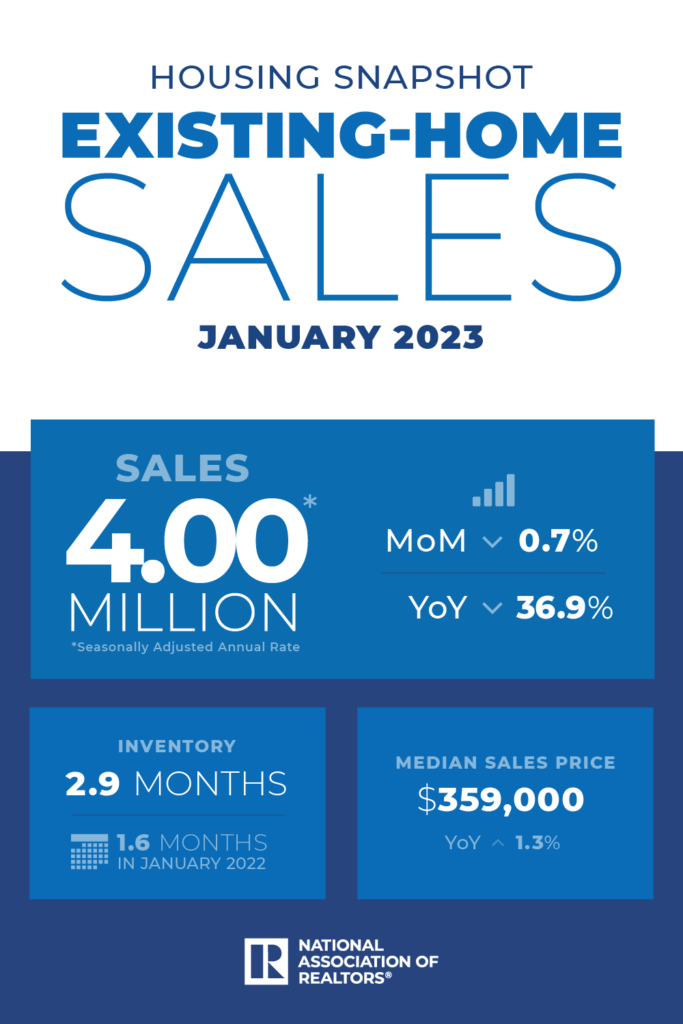According to the National Association of Realtors (NAR) , existing-home sales fell for the 12th consecutive month in January, slid 0.7% from December 2022 to a seasonally adjusted annual rate of four million. Year-over-year, sales retreated 36.9% (down from 6.34 million in January 2022). Month-over-month sales were mixed among the four major U.S. regions, as the South and West registered increases, while the East and Midwest experienced declines. All regions recorded year-over-year declines.
, existing-home sales fell for the 12th consecutive month in January, slid 0.7% from December 2022 to a seasonally adjusted annual rate of four million. Year-over-year, sales retreated 36.9% (down from 6.34 million in January 2022). Month-over-month sales were mixed among the four major U.S. regions, as the South and West registered increases, while the East and Midwest experienced declines. All regions recorded year-over-year declines.
NAR defines total existing-home sales as completed transactions that include single-family homes, townhomes, condominiums, and co-ops.
“Home sales are bottoming out,” said NAR Chief Economist Lawrence Yun. “Prices vary depending on a market’s affordability, with lower-priced regions witnessing modest growth and more expensive regions experiencing declines.”
Total housing inventory registered at the end of January was 980,000 units, up 2.1% from December and 15.3% from one year ago (850,000). Unsold inventory sits at a 2.9-month supply at the current sales pace, unchanged from December but up from 1.6 months in January 2022.
“Inventory remains low, but buyers are beginning to have better negotiating power,” Yun added. “Homes sitting on the market for more than 60 days can be purchased for around 10% less than the original list price.”
The median existing-home price for all housing types in January was $359,000, an increase of 1.3% from January 2022 ($354,300), as prices climbed in three out of four U.S. regions while falling in the West. This marks 131 consecutive months of year-over-year increases, the longest-running streak on record. Properties typically remained on the market for 33 days in January, up from 26 days in December and 19 days in January 2022. Fifty-four percent of homes sold in January were on the market for less than a month.
“The number of homes for sale is recovering, and combined with fewer buyers in the market, balance is shifting back toward those who are shopping,” said Realtor.com Chief Economist Danielle Hale. “Months’ supply–the number of months it would take to sell all currently unsold homes at today’s sales pace–held steady at 2.9 months, roughly on par with the level it has seen since May 2022, but up from 1.6 months one year ago. Although buyers face less competition from others, home prices are still high and mortgage rates are up compared to one year ago meaning that while buyers have some advantages, other challenges remain.”
Regionally, existing-home sales in the Northeast retracted 3.8% from December to an annual rate of 500,000 in January, down 35.9% from January 2022. The median price in the Northeast was $383,000, up 0.3% from the previous year. In the Midwest, existing-home sales slid 5.0% from the previous month to an annual rate of 960,000 in January, declining 33.3% from one year ago. The median price in the Midwest was $252,300, up 2.7% from January 2022. In the South, existing-home sales rose 1.1% in January from December to an annual rate of 1.82 million, a 36.6% decrease from the prior year. The median price in the South was $332,500, an increase of 3.4% from one year ago. And in the West, existing-home sales rose 2.9% in January to an annual rate of 720,000, down 42.4% from the previous year. The median price in the West was $525,200, down 4.6% from January 2022.
First-time buyers were responsible for 31% of sales in January, identical to December but up from 27% in January 2022. NAR’s 2022 Profile of Home Buyers and Sellers found that the annual share of first-time buyers was 26%, the lowest since NAR began tracking the data. All-cash sales accounted for 29% of transactions in January, up from 28% in December and 27% in January 2022.
Individual investors or second-home buyers, who make up many cash sales, purchased 16% of homes in January, unchanged from December but down from 22% in January 2022.
Distressed sales–comprised of foreclosures and short sales–represented 1% of sales in January, identical to last month and one year ago.
Single-family home sales declined to a seasonally adjusted annual rate of 3.59 million in January, down 0.8% from 3.62 million in December and 36.1% from one year ago. The median existing single-family home price was $363,100 in January, up 0.7% from January 2022.
Mortgage rates fell into the low six percent range in late January, according to Freddie Mac, January ended with the fixed rate mortgages at 6.02%, but have risen over the past few weeks.
“Lower mortgage rates toward the end of 2022 are likely a factor behind the floor in home sales that appears to be developing,” added Hale. “As observed in recent months, the share of first-time home buyers is up compared to one year ago, as decreasing buyer competition creates opportunities. In January, first-time homebuyers made up 31% of purchasers, on par with December 2022 and up from January 2022 (27%).”

 theMReport.com Your trusted source for mortgage banking news
theMReport.com Your trusted source for mortgage banking news








